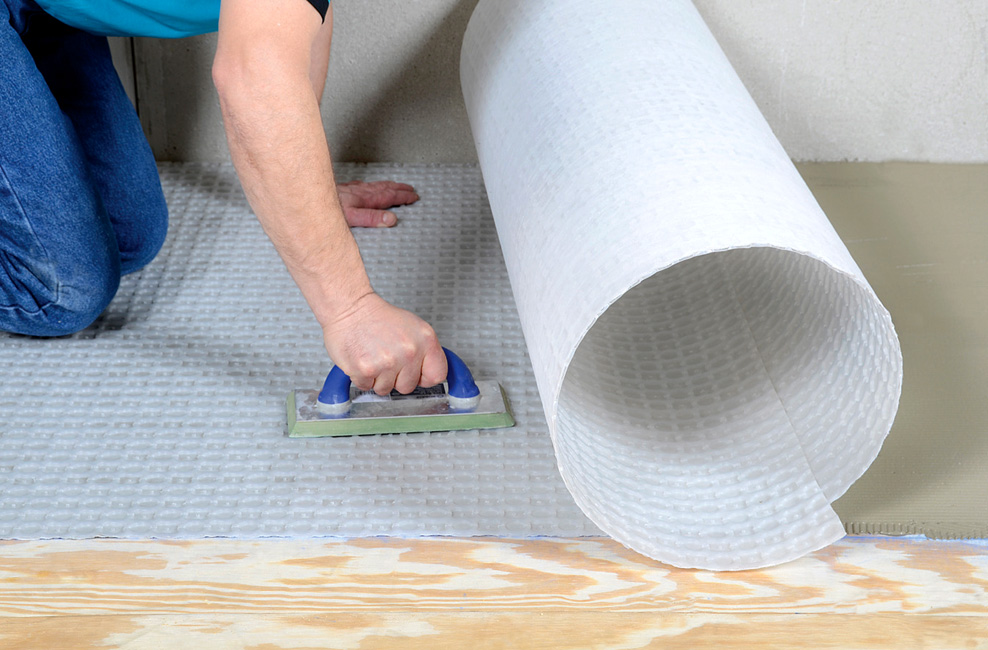The more versatile and adaptable a tiling system is – relative to solving installation problems – the better it is for our industry, and of course, its pursuit to be the first choice in flooring finishes.
The ability of a tiling system to accommodate varying project requirements and installation shortcomings is constantly improving and helping the tile industry push ahead of the competition. For instance, in coming to terms with some of these shortcomings, progressive minded adhesive companies have developed systems such as one-step sound control adhesives, crack suppression membranes and anti-fracture adhesives which have made tiling more productive, problem solving, and competitive.
Another problem solving system that is worthy of discussion is that of uncoupling mats. According to the TCNA, “An uncoupling membrane is a plastic membrane system geometrically configured to provide air spaces between the tiles and the substrate to allow independent movement between the two and limit the transfer of stresses”. In simpler English, an uncoupling membrane is an underlayment system that restricts or limits unwanted stress in tiling backgrounds by providing a buffering or stress absorbing layer within the construction of the underlayment.
The way it works is not very different to the principle of isolation I used years ago when installing terracotta tiles to paths and verandas at home. Rather than putting a concrete slab down on what is considered a reasonably reactive clay soil in my area, I laid a contained sand bed and then installed my tiling system – which included a mortar bed – directly on top of this sand bed.
I effectively placed a buffering or stress absorbing layer between the ground and my tiling system which has appeared to stand the test of time over the last fifteen years.
The ground continues to move but the sand isolates the tiling system. Whereas this method is seemingly better suited for internal construction, it certainly served its purpose in my external installation.
However, up to now one of the more common ways to deal with isolating stress from an array of building backgrounds has been with unbonded screeds or mortar beds. Essentially, in accordance with AS3958.1, a wire reinforced mortar bed (upwards of 40mm thick) is laid on a separating layer to totally divorce the underlayment from the background to mitigate stress.
As much as this process works, unbonded screeds or mortar beds are labour intensive, extremely heavy, and generally add unacceptable excessive height to most backgrounds. Another issue is the common use of polyethylene as the separating layer, which in some cases traps moisture in the background.
The other common way for providing underlayment over timber backgrounds is with cement backer boards. This technique is also regarded as being labour intensive, although it does provide for less weight and a more practical solution in comparison to the unbonded mortar beds in some circumstances.
To assist the industry in providing better, more versatile and adaptable solutions, Uncoupling Membrane Systems are emerging as an alternate underlayment of choice to replace those less efficient and inconvenient systems. They have many of the advantages of debonded systems without a lot of the disadvantages associated with other more traditional methods, including unbonded mortar beds and cement backer board underlayment.
They are thinner, some being nominally two millimetres thick, and when compared to a 40mm thick unbonded mortar bed, the choice is obvious. They are lighter, too. Some uncoupling membranes weigh less than 1kg per square metre compared to 80 kilograms per square metre for mortar beds, or 8 to 25 kilograms per square metre for commonly used cement backer boards. Uncoupling membranes clearly are the obvious choice when weight counts – and that is generally all the time!
But perhaps the single most important advantage offered by the Uncoupling Membrane System is total productivity that can make jobs more profitable.
As outlined before, these systems are lighter, which makes them easier to transport and handle on site. They are extremely quick and easy to install, cutting out lengthy delays with shorter installation times. They are cleaner and less hazardous, and tile can be installed immediately after the membranes have been laid. They offer installers the autonomy to quickly finish one job and get on to the next.
These Uncoupling Membrane Systems are designed for use under ceramic tile and stone – including moisture sensitive stone – in both residential and commercial installations. Additional features, such as built-in ventilation systems for proper adhesive drying; background vapour management; and mechanical locking of the adhesive systems, are sometimes incorporated.
And, just because they are plastic, do not think they deliver lightweight performance. Some systems have been rated for use in Extra Heavy duty installations and will meet the challenges of more trying installations, including point loading.
A recent cost comparison against some of the more traditional systems has proven that these Uncoupling Membrane Systems are extremely cost effective, as well.
By Fred Gray, Laticrete Pty Ltd

